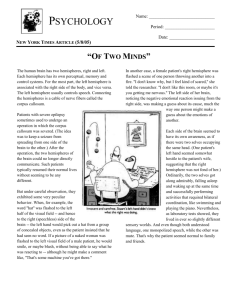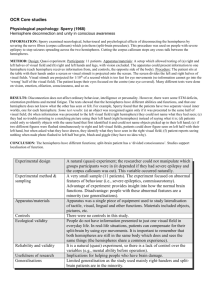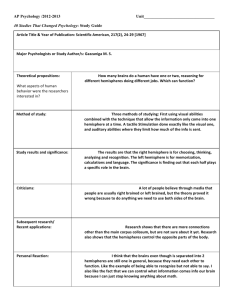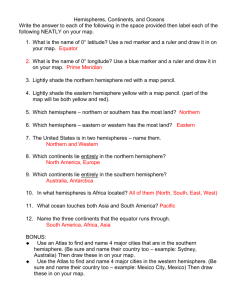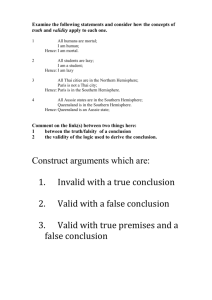the right hemisphere is dominant for visuospatial tasks
advertisement
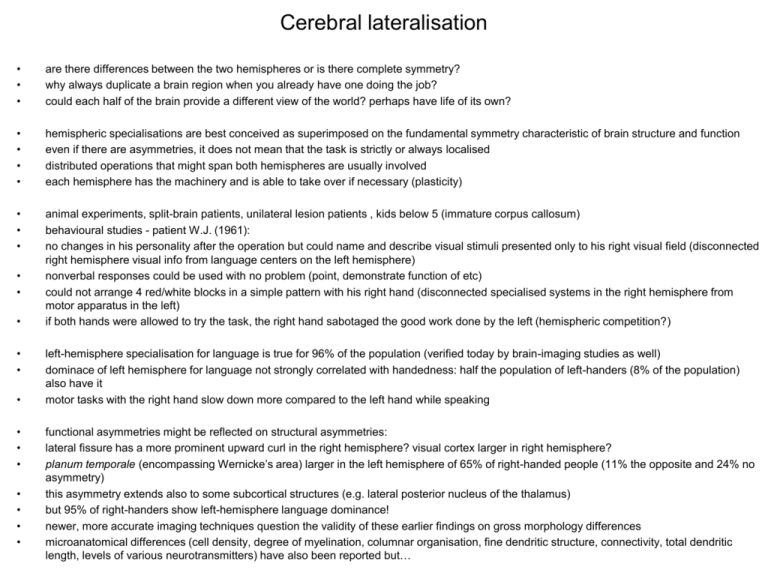
Cerebral lateralisation • • • are there differences between the two hemispheres or is there complete symmetry? why always duplicate a brain region when you already have one doing the job? could each half of the brain provide a different view of the world? perhaps have life of its own? • • • • hemispheric specialisations are best conceived as superimposed on the fundamental symmetry characteristic of brain structure and function even if there are asymmetries, it does not mean that the task is strictly or always localised distributed operations that might span both hemispheres are usually involved each hemisphere has the machinery and is able to take over if necessary (plasticity) • • • animal experiments, split-brain patients, unilateral lesion patients , kids below 5 (immature corpus callosum) behavioural studies - patient W.J. (1961): no changes in his personality after the operation but could name and describe visual stimuli presented only to his right visual field (disconnected right hemisphere visual info from language centers on the left hemisphere) nonverbal responses could be used with no problem (point, demonstrate function of etc) could not arrange 4 red/white blocks in a simple pattern with his right hand (disconnected specialised systems in the right hemisphere from motor apparatus in the left) if both hands were allowed to try the task, the right hand sabotaged the good work done by the left (hemispheric competition?) • • • • • • • • • • • • • left-hemisphere specialisation for language is true for 96% of the population (verified today by brain-imaging studies as well) dominace of left hemisphere for language not strongly correlated with handedness: half the population of left-handers (8% of the population) also have it motor tasks with the right hand slow down more compared to the left hand while speaking functional asymmetries might be reflected on structural asymmetries: lateral fissure has a more prominent upward curl in the right hemisphere? visual cortex larger in right hemisphere? planum temporale (encompassing Wernicke’s area) larger in the left hemisphere of 65% of right-handed people (11% the opposite and 24% no asymmetry) this asymmetry extends also to some subcortical structures (e.g. lateral posterior nucleus of the thalamus) but 95% of right-handers show left-hemisphere language dominance! newer, more accurate imaging techniques question the validity of these earlier findings on gross morphology differences microanatomical differences (cell density, degree of myelination, columnar organisation, fine dendritic structure, connectivity, total dendritic length, levels of various neurotransmitters) have also been reported but… - callosal projections mainly and extensively link together homotopic areas of the brain - less frequently they also connect heterotopic areas of the brain but with less extensive connections - mostly “association” cortices are connected primary cortices are not so much connected by the callosum: - there are a few connections between the most eccentric regions of the visual field between visual cortices - very sparse connections in the primary motor and somatosensory cortices - callosal connections are usually thought as synergistic - but could they also be inhibitory, revealing a competition between the two hemispheres for the control of current processing? - cats and monkeys loose approximately 70% of their callosal axons during development - autistic patients have a smaller callosum (number and diameter of axons? proportion myelinated? thickness of sheath? vessels?) - gender, handedness, mental retardation, schizophrenia correlates? Hemisphere communication specificity of callosal function - callosum matures between 5-10 years of age (younger kids are bad in combining intra-hemispheric info) - callosum subdivisions are organised into functional zones - posterior regions (splenium) are more concerned with visual information - more anterior regions carry auditory and tactile information - anterior part seems to be involved in high-order transfer of semantic information - results from two-stage procedure in neurosurgery are enlightening: transfer of visual, tactile and and auditory info is severy disrupted at first, by sectioning the posterior half the transfer of semantic info about the stimulus remains and is abolished in the 2nd stage - - Wada test (50s): the ability to speak or to comprehend speech is disrupted for up to several minutes behavioural studies on laterilisation the right hemisphere is dominant for visuospatial tasks (inconsistent result?) whereas the left for language and speech (but split-brains can learn) profound deficit in the interhemispheric transfer of sensory (both vision and touch) and motor information in split-brain patients Navon (1977): local vs. local stimuli. RT times faster for identifying global elements + non-symmetrical interference (global unaffected). Robertson (1988): in patients with unilateral lesions: left-sided lesions slowed down local target identification whereas patients with right-sided lesions were slower in global identification Robertson (1993): split-brain patients are faster with local targets in the RVF and global targets in the LVF both hemispheres can do it but differ in efficiency: left is local whereas right is global? Auditory perception - - - - vision studies are easier because of complete laterilisation of input: e.g. subjects are more adept to recognise that a string of letters forms a word when this string is presented to the RVF for auditory perception we can use the dichotic listening task in which we assume that the ipsilateral projections from each ear are suppressed: a right-ear advantage is revealed in linguistic memory tasks whereas the opposite was found for melody recognition The spatial frequency hypothesis: right is low (global) and left is hight (local) - Sergent (1982): the spatial frequency hypothesis as a computational basis for hemispheric asymmetries in visual perception - speech perception also depends largely on high sounds frequencies, whereas prosody (disrupted more by lesions on the right hemisphere) depends on low frequencies Sergent (1985): performance on a male-female task (low spatial-frequency) revealed a LVF advantage, whereas performance on an identification task (high spatial-frequency) a RVF advantage - in vision: identification vs. localisation (ventral vs. dorsal pathways) - studies of hemispheric asymmetries have not been limited to “what” but also to “where” problems - Kosslyn (1987): categorical vs. coordinate representations of spatial relationships - left-hemisphere forms categorical representations (essential in recognising objects, e.g. letters) - right-hemisphere forms coordinate representations (essential for action) - Kosslyn (1989): near-far task seems to verify this hypothesis BUT had problems with replication, disappeared with practice and also has alternative explanations the categorical vs. coordinate theory and an alternative SF explanation Wolford (2000): split-brain patients hemipsheric differences in problem solving: maximising (animals + right) vs. matching (humans + left) Prototypes (left) vs. Exemplars (right) - lesions in the right hemisphere make people deficient in both expressing as well as recognising facial expressions - in normal subjects, right hemisphere dominates when there is a conflict Do the 2 hemispheres share a common attentional mechanism or not? 4 other theories on laterilisation: Speech production requires the bilateral coordination of the muscles required fro articulation which might have created pressure to localise control in a single focus in order to avoid slow interhemispheric communication and so a left-hemisphere advantage for language followed, since this hemisphere had primary access to the speech production system (in general: things happen faster when one ‘person’ decides!) Davidson (1995): right vs. left prefrontal cortex in approach vs. withdrawal behaviors: - left frontal lobe damage causes severe depression whereas right frontal lobe patients appear manic - it also happens that language is the most social of all behaviours - emotional stimuli differentially activate left and right depending on whether they are positive or negative in nature - differential human EEG activation in reward vs. penalty trials in a financial task - higher left-EEG in 3-year-olds which are quite content to leave their mother and play with toys (and vice versa) Hemispheric specialisation in animals - - - birds do not have a corpus callosum and are better in categorising (e.g. food/no food) stimuli viewed in their right eye left eye better in tasks that have to do with learning specific colours, shapes, sizes and spatial locations this supports the prototype vs. exemplar hypothesis? - sectioning a canary’s hypoglossal nerve in the left hemisphere severely disrupts song production (right-hemisphere lesions have little effect) - nonhuman primates might prefer using one hand over the other but there is no consistent trend in motor preference - Rhesus monkeys like humans have better tactile discrimination of shape with left hand - split-brain monkeys have a righthemisphere advantage in face recognition tasks and a left-hemisphere advantage in in orientation discrimination - left-hemisphere lesions in the Japanese macaque produces a relative mild (and transient) impairment in comprehending the vocalisation of conspecifics
